A Davenport history feature, written by Charlie Hulme
Davenport Station home | Index to History pages
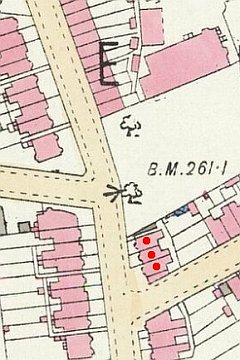
The area in 1892: 175 to 177 are marked by red dots.
This is the story of three of the older houses on Bramhall Lane, which were later turned into shops, and more recently have become eating and drinking premises.
This page expands on the the general history of some other Bramhall Lane buildings and wealthy mill owner Ephraim Hallam who developed the area. See our feature Ephraim Hallam's Legacy.
The history of individual shops, in the late twentieth century in particular, can be hard to discover. If you know more about the people who lived and worked in this terrace, please get in touch.
Over the Years

1931
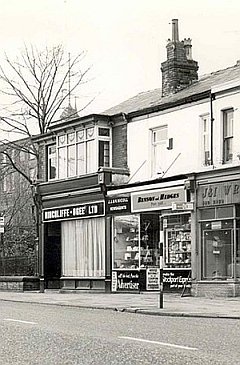
1975

2019
The view from above
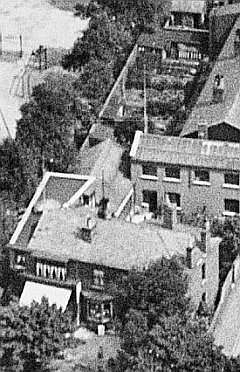
This extract from an aerial view taken in 1927 shows the extension to no. 175 and its rebuilt frontage, with the cabinet-makers workshop behind. The industrial building in the centre of the picture may have been part of the furniture-making business. No. 177, the newsagent, retained its house front until much later, whereas no. 179 (not visible in this view) did receive an Edwardian-style shopfront, remnants of which remain in 2019.
The houses along Windsor Street, most of which had outside toilets, as seen at the top of the image, have since been replaced by modern housing. Windsor Street itself, which had its own 'corner shop' run for many years by Ernest and Priscilla Hazeldine, no longer exists. A short section off Bramhall Lane has been re-named as part of Peel Street. To the left is the Hallam Recreation Ground, with its original hard surface (the 'red rec'), contrasting with the gardens of today which were created in the 1950s to commemorate the Queen's coronation.
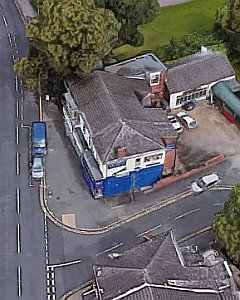
2018, looking in the opposite direction to avoid obstruction of the view by the tree.
Mary Alcock
Before Ephraim Hallam, at the time of the Tithe map of 1850, these fields were owned by Mary Alcock, and rented to various farmers. Who was Mary Alcock? In our earlier research we didn't pursue that question, so we'll try this time. She was sure to have been the wife or daughter of someone of substance in the area. What follows may well be wrong, if it is, please let us know
John Alcock (b.1787) was a Manchester - born cotton mill owner who by 1851 was living in retirement at Gatley Hill House in the village of Gatley not far from Stockport.
His son, also John Alcock, born in 1820, inherited the firm and became a wealthy man. He was born in Stockport, but in 1851 he was living, aged 32, with his new wife Mary Alcock (née Thornely, (25) and their three-month old baby John Herbert Alcock in Hudcar, Bury. Also present was visitor Helen Thornely (age 23, Mary's sister?) and three domestic servants. He described himself as 'Cotton spinner of Manchester employing 300 hands.'
It is this Mary Alcock that we believe was the owner of the fields in 1851, 'made over' to her by her father on her marriage, as was common at the time. Tracing her ancestry has proved difficult, but we note that among a list of Presidents of the Hyde Mechanics Institute we find Thomas Thornely, Esq. President in 1861 and John Alcock, Esq. in 1863; both men were wealthy cotton spinners and no doubt good friends.
In a register of non-conformist marriages, we find: Mary, Daughter of John Thornely of Hyde by his wife Elizabeth, daughter of Charles and Betty Oldham, was born Sept. 11th 1825 and baptised October 20th 1825. Surely this is 'our' Mary, and John and Thomas Thornely were related, but we can't quite make the link.
By 1861 the Alcock family had moved to a very large house, Highfield Hall (or House) in Bredbury, on the road from Stockport to Hyde, built for William Crowther, owner of a silk-throwing mill in Stockport. In 1861 it was home to 16 people: John Alcock, Mary, eight children aged from three months to ten years, a governess, a cook, two housemaids and two nurses.
Mary Alcock died in 1866, by which time the land by Bramhall Lane had been sold to Ephraim Hallam. In the 1871 census, 'Highfield Hall' had a whole page of the listing to itself, with 22 people present including John's new wife, Mary Ellen (Born in London), seven servants and three visitors. John, now aged 51 stated he employed 2850 people.
John Alcock of Bredbury died in 1891 and in the 1920s, after being used as a hospital in World War One, the house and its estate were purchased by Bredbury and Romiley Urban District Council for use as a cemetery and public space, The house was demolished; it stood close to the site of the later cemetery chapel at the end of Highfield Avenue.
Sources and thanks
This page has been compiled from information in:Ancestry.co.uk
Cheshire Tithe Maps
The Land Registry
Stockport Heritage Library
Street Directories
Google maps
Special thanks to Sue Bailey for the use of her father's photographs, and Mr Redhead who explained the complexities of the Champ family.
Contributions are very welcome:
info@davenportstation.org.uk

Around 1875 a terrace of three houses which became 175, 177 and 179 Bramhall Lane, were built on land which had been transferred by Ephraim Hallam to two of his senior employees, mill manager David Fogg and book-keeper Robert Johnson. The three houses are marked by red dots on the map. For some reason, they were built at a slight angle to the line of the road; all three originally had front gardens, which were used to widen the pavement and add shop frontages.
The Land Registry records that in 1876 Fogg and Johnson leased the whole terrace to 35-year-old Stockport native Joshua Williamson, a self-employed 'carding engine coverer'. It's likely Joshua was well-known, as one of his customers, to mill manager Mr Fogg, who offered him the chance to move into a new house from the previous family home in Duke Street, off St Petersgate in the town centre and earn money by renting the other two.
By 1881 Joshua Williamson was living at No.175 with his wife Mary (39) a former cotton weaver, and three daughters Elizabeth (11), Mary and Annie. They were joined by a son, John, in 1888. The 1891 census reveals that Elizabeth and Mary worked as Hat Trimmers in one of Stockport's hat factories (or possibly worked at home as 'out-workers') while Annie worked at home as a dressmaker; John was at school. By 1901, Elizabeth and Mary had married, while Annie continued with her dressmaking.The image above shows numbers 175 (nearest camera), 177 and 179 Bramhall Lane in a Grenville Series postcard. The date of the image is unknown, but the white banding on the trees seems to suggest that it was taken during World War I when night-time 'black-out' was enforced for rear of Zeppelin raids. The wall in the foreground is at the corner of the Heaviley Recreation Ground, given to the Council by Hallam's widow.
By that time all three houses had become shops, taking advantage of their position along the busy road. 175 and 177 had simply lost their front gardens at that time, while No. 179 had gained a ground floor shop frontage. 177, which would eventually be altered in the same way, shows signs of its use as a newsagent and stationer; its wares are attracting the attention of a young boy.
No. 175
The Williamson family (see left column) lived in the terrace for many years, mostly at No.175, although the 1901 census has them at no. 179, which according to a 1902 directory was a draper's shop, presumably run by Annie. No. 175, while still a house, was for a while rented to Joseph Pontefract, but by 1907 the Williamsons had returned.Joseph Pontefract was a mineral merchant's clerk, born in Heaton Norris in 1851. The 1901 census lists him with his wife Mary H (aged 50), with their children Mary J. (26, felt hat trimmer), Harry (22, clerk,cotton mill), Gertrude Margaret (18), Sydney Herbert, (15, Clerk, hat works), Irene Maud (12, later became a draper's assistant)) , Lionel (10) , and Ivy (8, later became a bookbinder's folder). By 1911, Mrs Pontefract had died, and the family members still at home were living across the road at 56 Bramhall Lane. It is at good example of the custom of the day that however house became, it was unusual for children to leave the family home unless they married.
Joshua Williamson carried on his carding machine work while John trained as a cabinet maker, establishing a workshop in a building behind no.175, which remains a cabinet maker's workshop in 2019.

At some stage No.175 was given an elaborate 'make-over'; it appears that the unusual ornate window in the upper storey was installed, and the building itself may have been extended to provide the doorway which leads to the upper floor. The image above, looking towards Stockport in the 1920s, shows the result, perhaps intended to impress furniture buyers. Beyond is the area of land presented to the town by Ephraim Hallam's executors as a public recreation ground, with the mill building visible behind the trees. The view here is remarkably similar to today, except that the road is now tarmac and there is more 'street furniture' about. Very few shops now have the retractable sun shade which was common to small shops until well into the twentieth century.
By 1911 Joshua had died, leaving just John Williamson and his mother at 175. In 1912, Mary transferred the lease to John, who was still in business there making furniture in 1939, with his wife Ethel looking after the shop as 'House duties, retail dealer, furniture.' 'Williamson's, Furnishers' is listed in the telephone directory until 1959.
For the next few years, the shop disappears into that dearth of easily-accessible records that marks the post-war period. In the 1970s (above) it seems to have been used as an office for Hinchliffe-Ogee Ltd, about which we have failed to find any information.

In 1979 no. 175 was bought by Henry and Gillian Barker who established the retail outlets of 'HB Printing' and 'GB Trophies'. The picture above, by Philip Bradley, is dated 1989. Later, no. 177 came into the same ownership, and the trophy shop moved in, freeing no. 175 to open as the asset to the area which is the Monkey Coffee Company, which opened in 2008.
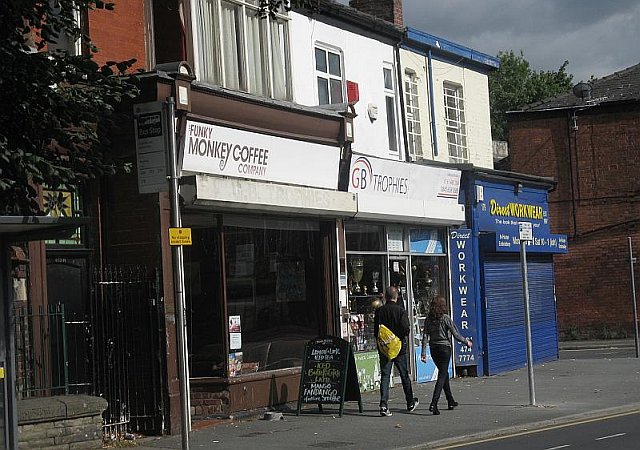
Above, a view dated 2017. In 2019 GB Trophies, a remarkable shop full of many kinds of trophies for sports activities and similar, re-located to 324 Buxton Road, giving the Monkey Coffee team a chance to create much-needed extra space.
No.177
The 1881 census recorded the house No. 177 as unoccupied. The tenant in 1891 was Stockport-born Walter Torkington, corn dealer's assistant, aged 34 with his wife Emma (35) and their children Lucy (8), May (4) and Walter (2). The Torkingtons were still there in 1896, Walter now described as a 'manager.'
By 1901, however, the shopping era had begun, and 177 had become a Newsagent and Stationer, run by 63-year-old householder Emma Lowndes. Living with her was her 37-year-old nephew James Hopkins, a Yorkshire-born Railway Company Inspector, her 39-year-old niece Barbara Hopkins, and her 73-year-old widowed sister, Mary Ducket, born in Sheffield. The postcard view at the head of the page is from that time: the house frontage has not been altered, but assorted items for sale can be seen in the window.
Emma, born in Wolverhampton, came from a background of domestic service. In 1891 she was a housemaid, one of fourteen servants needed to run a mansion called Aston Hall in North Ferriby, East Yorkshire, built and occupied in the 1740s by William Wilberforce - grandfather of the William Wilberforce famous for his anti-slavery Bill in Parliament. Her employer in 1881 was Frederick Constable, 'gentleman.' By 1911, Emma, now aged 73, was the only occupant,.
The shop remained a newsagent and stationer for many years. A 1934 directory lists the shopkeeper as James Mason, as shown in the 1931 image, and the 1939 Register lists William and Ann Barnes, 'stationery and tobacco'. The 1970s owners were the McColls, and in the 1980s, by which time a new aluminium shopfront had been installed, the Penneys.
No.179
In 1881, the first census appearance of the row, No. 179 was home to Robert Jones, a 28-year-old hatter born in Ashton-under-Lyne, his wife Mary Jones and their lodger Walter Brown, also a hatter. What happened to them later we cannot at present establish; the common surnames make research difficult.
The householder in was 1891 Miss Emily Aveyard (aged 42, born in Gorton, Lancashire) with two nephews - James Robert Aveyard, a clerk aged 17, Albert Augustus Aveyard aged 14, scholar - and two nieces, Florence, aged 16, a milliner's apprentice and and Elizabeth M. Aveyard, aged 10, scholar.
Emily was the eldest daughter of William Aveyard, a Gorton-born buyer and seller of yarn, and his wife Elizabeth. In 1871 the couple had been living in Cheadle Heath, with their three sons (George, Joseph and William, all working in the family firm as salesmen) and five daughters. The children's birthplaces reveal that the family had moved several times between addresses in the south Manchester area, and by 1881 they had moved again, to a house at 139 Heaviley, Stockport, on the main Buxton Road by which time William had retired.
The 1881 Heaviley census lists at no. 139 Robert James (Presumably the 'James Robert' of 1891) and Florence as grandchildren, apparently children of Joseph by his wife Elizabeth Woodall who had died in 1885; there were eleven people living in the house at that time. Not surprising, perhaps, that Emily rented No. 179 with her nephew and nieces, possibly funded by her father.By 1901 we find that the Aveyards have moved on; Emily returned to her birthplace, Gorton, where by 1911 she was living alone in a house at 28 Athol Street, Gorton. She died in 1926.
At No. 179 Joshua Williamson, still landlord of the three houses, had moved in by 1901 and turned the house into a draper's shop run by his daughter Annie, while John lived there with them while working in the cabinet-maker's workshop.
A 1905 directory shows a new tenant for the draper's shop: Hannah Beaty. She was born around 1830 in Waringstown, County Down, Ireland, arriving in Stockport as a child when her father, a carpenter, emigrated to England, to live at 31 Cheapside, Stockport In Stockport she trained in (or taught herself) dressmaking.. The 1891 and 1901 census found her at 20 Windsor Street, around the corner from the terrace; in 1901 she gave her occupation as self-employed 'linen draper and hosier'. Sharing the house was her in 1901 niece Edith Johnson, also a draper. By 1911, by then aged 81, still unmarried, she had sold the business and retired to live with her brother-in-law Robert Johnson at 41 Kennerley Road, Davenport. She died a year later.
The drapery business, with its living quarters, at 179 passed to Mary Millicent Dowbiggin (born 1875) and Edith Champ, both unmarried and describing themselves in 1911 as 'fancy drapers'. Mary listed herself as householder, and Edith as 'partner' which perhaps did not have all its modern associations as that period. Mary Millicent was a daughter of John Dowbiggin, a 'commission agent' born in Caton, Lancashire and his wife Mary who hailed from Tideswell, Derbyshire. Their home in 1881 was in Lyme Street (later re-named Lyme Grove), Shaw Heath, Stockport. By 1891 the family had moved a short distance to 12 Lowfield Grove, and John was described as a 'slate merchant'.
In 1920 the Land Registry records a lease of the shop from hat manufacturer Charles Tatton Lees, who probably purchased the land from Ephraim Hallam's estate, to Mary Millicent Dowbiggin at an annual chief rent of £2.10.0. Mary Millicent was listed in 1891 as a 'hat leather stitcher's assistant' and in 1901 as a 'patent hat-leather machinist', probably working for Dean and Co., hat leather manufacturers, of St Petersgate, Stockport, one of a number of specialist firms ancillary to Stockport hatting trade. From this experience, and perhaps making clothes at home for the family, she was able to set up in business as a draper. She appears in a 1934 directory at no. 179, but in the same year she died.
Edith Champ, born c. 1878 in Chorlton-cum-Hardy, was a sister-in-law of Charles Arthur Hague, a corn merchant who in 1901 lived at 215 Bramhall Lane before its conversion to a shop. Edith, noted as a 'seamstress, shirt' was living with the Hague family at that time . In 1939 she was at 44 Devonshire Road, the home of Charles Tatton Lees who was her step-half-brother. Her occupation at that time given as 'apartment housekeeper'.
Edith, who died in 1943, was one of fourteen children fathered by Henry Champ (1839-1918) and born to three successive wives, all called Sarah. He worked for cotton merchants S & J Watts, and by 1911 had become the company Cashier, equivalent to a Finance Director in modern terms.
His family home in 1911 was a mansion, 'Foxley House' in Lymm. Interestingly, amongs other things he was one of the 'passive resisters' who withheld payment of part of their local authority rates in protest against the 1902 Education Act which required councils to fund sectarian religious education of children. By the time of his death he was living at Heald Green House, Heald Green.
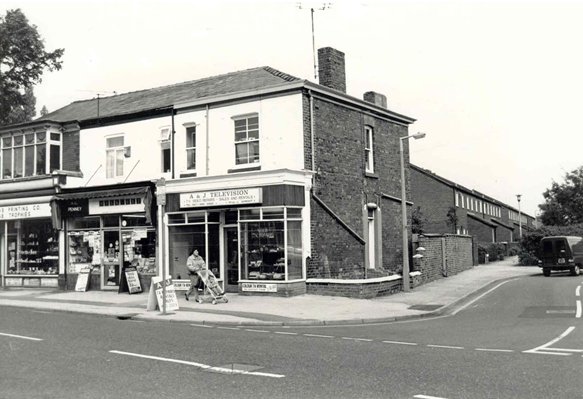
No. 179 is not mentioned in the 1939 directory; by then it would have become a 'lock-up' shop, no doubt with a series of tenants. There's a gap in our knowledge until 1975, when the business was 'J. & I. Wright', a radio and TV shop. In our own memories of the 1980s, 179 was in the same business as 'A & J Television.' as Philip Bradley's 1989 view above shows.
The most recent business before the 2019 re-build was 'Direct Workwear' - a draper of sorts, supplying yellow gilets and such - which on its bright blue and white end wall assured us it was 'established in 1997' and encouraged us to 'Kuman Avalukatus'.
In 2019 No.179 was acquired by Kilmal Property Ltd, who, with planning permission from the council, embarked on a major rebuild to create a public house and a first-floor flat.
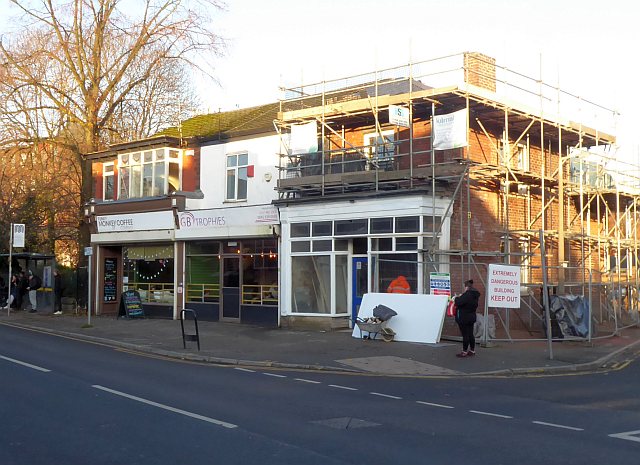
November 2019: the extended Monkey Coffee open for business and work ongoing on no.179. Unfortunately, by the time the building work was complete the 2020 virus 'lockdown' was in force, and any occupaltion was delayed.
Written by Charlie Hulme, December 2019. Updated June 2020. Comments welcome at info@davenportstation.org.uk